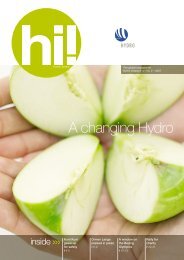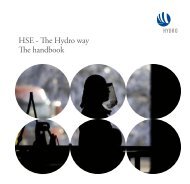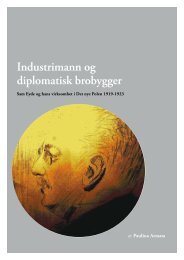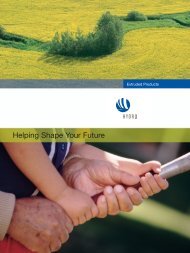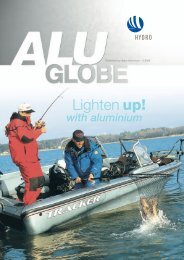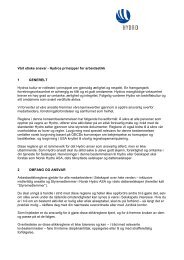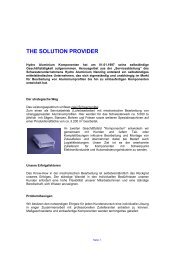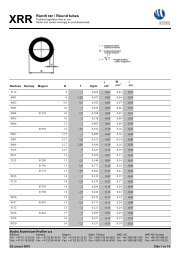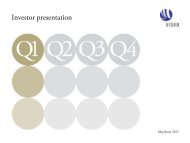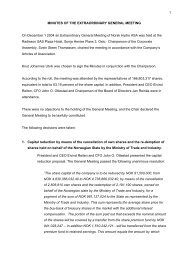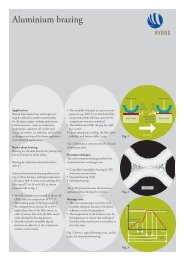Hydro Annual Report 2011b
Hydro Annual Report 2011b
Hydro Annual Report 2011b
You also want an ePaper? Increase the reach of your titles
YUMPU automatically turns print PDFs into web optimized ePapers that Google loves.
52<br />
vIABIlItY perForMAnCe<br />
Energy and climate change<br />
Cooperating to save energy<br />
Enova is a Norwegian governmental organization founded to<br />
promote environmentally friendly restructuring of energy generation<br />
and consumption. Enova is co-funding <strong>Hydro</strong> projects to develop<br />
more energy-efficient production processes. These projects are<br />
an important part of <strong>Hydro</strong>’s efforts to reduce specific energy<br />
consumption from new and existing plants. If successful, the<br />
technology could be used outside Norway and, in some cases,<br />
outside <strong>Hydro</strong>. One example is a project to increase heat recovery<br />
in the metallurgical industry. Enova’s support makes it possible to<br />
carry out projects that have a higher business risk than we usually<br />
allow for. In 2011, Enova contributed NOK 3.4 million to <strong>Hydro</strong>, see<br />
also page 69.<br />
achieved an energy consumption of 12.5 kWh per kg aluminium.<br />
We have initiated a program to widely pilot innovative<br />
technology solutions, which when implemented, will<br />
have the potential to reduce the energy consumption for all<br />
our primary metal plants by 200-400 GWh on an annual<br />
basis. These pilots are in the planning process and will be<br />
started in 2012.<br />
We work closely with customers to develop products that save<br />
energy and reduce emissions. Aluminium façades can lead to<br />
lower operating costs and enable buildings to produce as much<br />
energy as they consume during operation. <strong>Hydro</strong> has built<br />
three buildings that aim to be energy neutral during operation.<br />
<strong>Hydro</strong>’s test center in Bellenberg, Germany, produced 9,686<br />
KWh more energy than it used in 2011. This equals a self sufficiency<br />
of 126 percent. See also page 68.<br />
Lighter cars result in fuel savings and lower emissions on the<br />
road, and lighter aluminium products and packaging reduce<br />
transport costs and emissions. Excellent barrier properties<br />
reduce the cooling needs of food products while improving<br />
durability, thus reducing food spoilage. In 2011, <strong>Hydro</strong><br />
became one of 12 sponsors of SAvE fOOD, an initiative from<br />
the United Nations’ food and Agriculture Organization. Our<br />
specific contribution is packaging, in which aluminium helps<br />
to conserve food more effectively so it stays fresh longer with<br />
less cooling and is better protected for transport and storage.<br />
This helps reducing emissions in the food supply chain and in<br />
the consumption of beverages.<br />
We are currently upgrading several of our hydropower plants<br />
in Norway to secure future stable production. The Rjukan<br />
watershed, with a total annual normal production of 3 TWh<br />
from five plants in the Måna river, is the largest upgrade with<br />
an estimated cost above NOK 800 million. The project is<br />
expected to be completed in 2015. We are also working on<br />
increasing the production further within current assets. When<br />
finalized in 2012, the refurbishment of the Holsbru and Herva<br />
plants and construction of the vasstøl plant, will increase the<br />
potential electricity output by 150 GWh per year.<br />
Industry major user of energy<br />
“Climate and energy challenges must be solved largely through<br />
technology development. Innovative solutions must be able<br />
to be implemented on a large scale, by any company, through<br />
both the introduction of new processes and modifications to<br />
existing facilities. <strong>Hydro</strong> currently has a strong commitment to the<br />
development of the core process: what happens in the electrolytic<br />
cells. We see this as commendable, since it is here the bulk of the<br />
energy is consumed and most greenhouse gases are produced.”<br />
Nils Kristian Nakstad,<br />
Chief Executive Officer, Enova<br />
Read full interview at www.hydro.com/reporting2011<br />
We support the development of international frameworks on<br />
climate change and greenhouse gas emissions and participate<br />
actively in organizations such as the World Business Council<br />
for Sustainable Development and the International Emissions<br />
Trading Association, to provide business solutions to climate<br />
change. In addition, we work through aluminium associations<br />
to establish a level playing field globally for aluminium<br />
production.<br />
Remelting and recycling<br />
Aluminium can be recycled over and over again without degradation<br />
in quality. Aluminium recycling requires 95 percent<br />
less energy than primary aluminium production. This makes<br />
aluminium a material for the future. <strong>Hydro</strong> is a large remelter<br />
and recycler of aluminium, with nearly 30 facilities worldwide.<br />
We remelt process scrap from our own production and from<br />
other companies. Our expertise in remelting is a good basis for<br />
further expansion.<br />
Our ambition is to grow faster than the market in recycling and<br />
to take a strong position in this part of the value chain. By 2020,<br />
we aim to recover 1 million metric tons (mt) of contaminated<br />
and post-consumer scrap annually. We have improved utilization<br />
of our existing capacity to almost 100 percent during the<br />
last two years, and are now recycling more than 270,000 mt<br />
annually. Due to curtailments in remelting and recycling capacity,<br />
growth was only about 3 percent compared to 2010. In<br />
total, <strong>Hydro</strong> is remelting and recycling above 2 million mt of<br />
aluminium. Our goal for 2012 is to stabilize at above 90 percent<br />
capacity utilization and to develop specific post-consumed scrap<br />
projects for investment in additional capacity. This will also<br />
improve the carbon footprint of <strong>Hydro</strong>.<br />
In the next phase, we intend to invest in additional recycling<br />
assets to capture scrap volumes generated in our plants and<br />
from plants operated by our partners. One of our goals is to<br />
develop recycling plants that serve internal and external customers<br />
with metal products produced from contaminated<br />
industrial and end-of-life scrap. The previously announced<br />
investment in a recycling plant at Karmøy, Norway was



